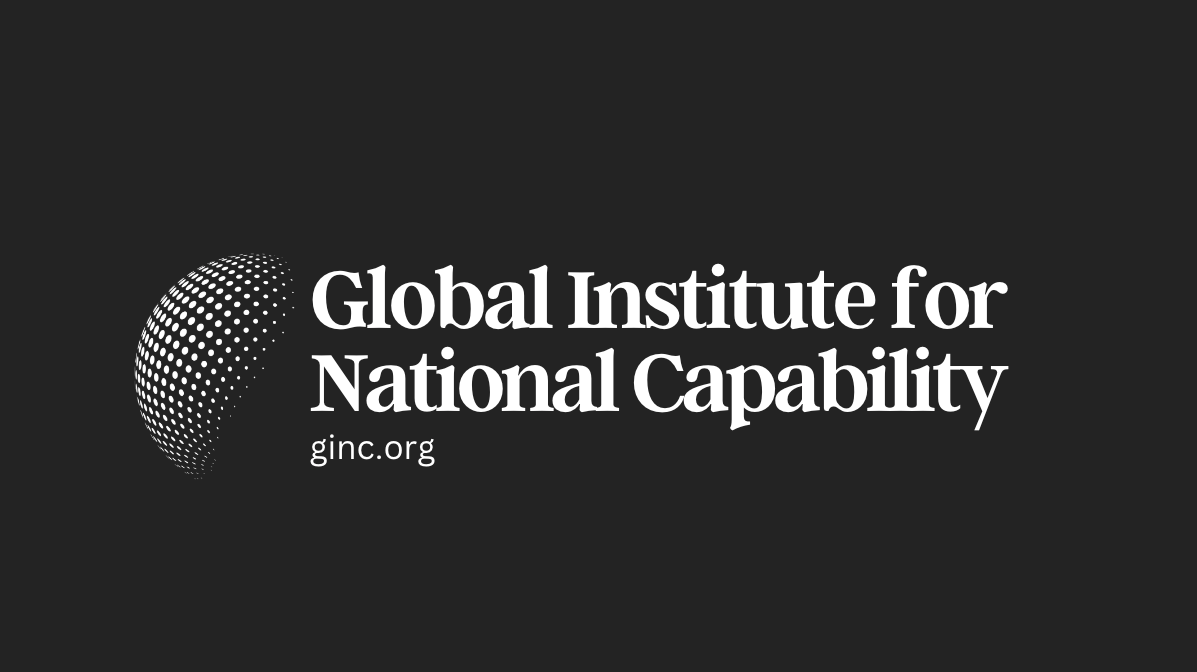Weekly Newsletter. Friday, January 17, 2025

In this week’s National Strategy and Strategic Capability Newsletter, we cover key economic, industrial, and trade developments from around the world. The U.S. economy continues to show resilience, while China faces economic headwinds with declining industrial profits. India’s job market expands as the country attracts foreign investment in infrastructure. In advanced manufacturing, the U.S. accelerates its semiconductor expansion, China strengthens its battery production dominance, and India launches a major aerospace manufacturing hub. Meanwhile, global trade shifts as the U.S. and EU advance trade negotiations, China deepens economic ties with Latin America, and India secures significant foreign direct investment. These developments highlight the evolving geopolitical landscape and the strategic decisions shaping national capabilities across key sectors.
National Security Capability
🛡️ Quad Foreign Ministers to Meet in Washington to Strengthen Indo-Pacific Strategy
The foreign ministers of Australia, India, and Japan are set to meet with the U.S. Secretary of State in Washington, marking the first major diplomatic engagement of the new administration. This meeting will reaffirm the importance of the Quad alliance in countering China's growing influence and enhancing regional security in the Indo-Pacific.
⚔️ India's Defense Minister Highlights Power Rivalry in the Indian Ocean
India's Defense Minister Rajnath Singh has underscored the strategic significance of the Indian Ocean region due to intensifying geopolitical rivalries. With 95% of India's trade passing through these waters, India's naval expansion is critical in countering China's increasing presence.
☢️ U.S. National Security Adviser Discusses China's Hydropower Projects with India
U.S. National Security Adviser Jake Sullivan visited New Delhi to address concerns over China's dam projects, which could impact downstream water availability for India and pose environmental risks. The discussions also included AI, space collaboration, and nuclear security cooperation between the U.S. and India.
National Technology Capability
🤖 U.S. Supreme Court Upholds Federal Ban on TikTok
The U.S. Supreme Court has upheld a federal ban on TikTok due to national security concerns regarding data collection by its Chinese parent company, ByteDance. The ruling affects 170 million monthly U.S. users, pending ByteDance's decision to divest its U.S. operations.
📡 U.S. Removes Indian Entities from Trade Restrictions While Adding Chinese Firms
The U.S. Bureau of Industry and Security has removed three Indian entities from its Entity List, facilitating energy and defense cooperation, while adding 11 Chinese firms over military-related concerns.
🖥️ U.S.-China Tech Rivalry Intensifies with New AI Export Controls
The Biden administration has implemented new export controls on advanced AI technology to limit China's access to cutting-edge computing power. While these measures could slow China's AI progress, they may also drive Beijing to accelerate its self-reliance strategy.
National Resources and Infrastructure
🏗️ India, U.S., Saudi Arabia, and EU Unveil Major Trade Infrastructure Project
On the sidelines of the G20 summit, India, the U.S., Saudi Arabia, and the EU announced a multi-nation rail and port initiative designed to counter China's Belt and Road Initiative. The project aims to enhance trade between India, the Middle East, and Europe, strengthening global connectivity.
🚧 India Completes 90 Border Infrastructure Projects Amid China Tensions
India has finalized 90 new border infrastructure projects, including tunnels, roads, bridges, and military airfields. These efforts are aimed at improving defense readiness and connectivity in strategically sensitive regions.
🌉 China’s Belt and Road Initiative Investments Outpace U.S. Efforts
China has invested $679 billion in infrastructure projects through its Belt and Road Initiative since 2013, significantly surpassing the U.S., which has contributed $76 billion in the same period. While the investments have improved global connectivity, they have also raised concerns about debt sustainability in recipient nations.
National Human Development Capability
📊 India’s Human Development Index Improves Amid Economic Growth
India's Human Development Index (HDI) ranking has improved, with the country's score rising to 0.644 in 2022, placing it 134th out of 193 countries. The United Nations Development Programme (UNDP) attributes this rise to increased life expectancy, improved literacy rates, and sustained economic expansion. However, India still faces challenges in reducing income inequality and improving healthcare access, which remain critical for long-term human capital development. (hindustantimes.com)
👶 China Sees Birth Rate Increase in the Year of the Dragon
For the first time since 2016, China has recorded an increase in birth rates, driven largely by cultural factors associated with the auspicious Year of the Dragon. Despite this temporary uptick, China’s population declined for the third consecutive year, with 9.54 million births compared to 10.93 million deaths, bringing its total population to 1.408 billion. This trend underscores China's ongoing demographic challenges, which could impact labor markets and economic growth in the coming decades. (ft.com)
🦠 India Monitors Respiratory Illnesses Following HMPV Outbreak in China
India's National Centre for Disease Control (NCDC) has intensified surveillance on seasonal influenza and respiratory infections after a Human Metapneumovirus (HMPV) outbreak in China. With China reporting a surge in cases, Indian health authorities are monitoring potential cross-border transmission risks and reinforcing preparedness measures. The response highlights the need for stronger regional health cooperation to prevent future pandemics. (economictimes.indiatimes.com)
National Communications Capability
🔌 U.S. Sanctions Chinese Firm Over Cyberattacks on Telecom Networks
The U.S. government has sanctioned Sichuan Juxinhe Network Technology Co., a Chinese firm implicated in cyber intrusions targeting U.S. telecommunications infrastructure. The cyberattacks, attributed to a state-sponsored hacking group known as Salt Typhoon, compromised sensitive data belonging to multiple U.S. government officials. These sanctions signal Washington’s intent to curb Chinese cyber activities and protect national communications infrastructure. (wsj.com)
🌐 U.S. and China Intensify Competition Over Undersea Internet Cables
The race for dominance over global undersea internet cables is escalating, with 95% of international data traffic relying on these networks. The U.S. and its allies are moving to block Chinese involvement in laying new cables, fearing espionage risks, while China accelerates its own infrastructure projects in Asia and Africa. Control over these cables is crucial for securing global communications and maintaining digital sovereignty. (time.com)
📡 Chinese Telecom Firm Baicells Under Investigation by U.S. Authorities
Baicells Technologies, a Chinese telecommunications firm founded by former Huawei executives, is under investigation by the U.S. Commerce Department and the FBI over potential national security risks. The firm supplies wireless equipment to over 700 networks across the United States, raising concerns about possible backdoor access and cyber vulnerabilities. The case underscores ongoing tensions between Beijing and Washington over telecommunications security. (reuters.com)
National Leadership and Policy Capabilities
🤝 India and China Move Toward Diplomatic Reconciliation
Recent high-level engagements between India and China suggest a move toward diplomatic rapprochement, sparking speculation over India’s long-term commitment to the Quad alliance (U.S., Japan, Australia, India). The thaw in relations could alter regional security dynamics, especially concerning the Indo-Pacific strategy and border tensions. (voanews.com)
🗳️ U.S. Global Leadership Approval Higher Than China’s
A new Gallup analysis finds that global approval ratings for U.S. leadership exceed those for China, with Washington maintaining a net positive perception in more countries. However, the gap has narrowed compared to previous years, reflecting the growing influence of China’s Belt and Road Initiative (BRI) and its diplomatic outreach in developing nations. The findings highlight ongoing competition for global leadership between the two superpowers. (voanews.com)
🌏 India Expands Global Influence as a Leading Voice for the Global South
India is positioning itself as a leader in Global South diplomacy, leveraging partnerships with both Western powers and emerging economies to counterbalance China’s dominance. By aligning with the U.S. and the European Union on trade and infrastructure while maintaining ties with developing nations, India seeks to expand its global footprint and influence international economic policies. (cfr.org)
National Strategy and Strategic Capability Newsletter
Key Developments in Economic, Industrial, and Trade Capabilities
National Economic Capability
💰 U.S. Economy Grows at 3.3% Amid Strong Consumer Spending
The U.S. economy expanded at an annualized rate of 3.3% in the fourth quarter of 2023, surpassing expectations despite rising interest rates and inflation concerns. The growth was driven by robust consumer spending and business investment, signaling resilience in the world’s largest economy. Policymakers are now assessing the balance between maintaining economic momentum and addressing inflation risks. (reuters.com)
📉 China’s Industrial Profits Decline as Domestic Demand Weakens
China’s industrial sector profits fell by 6.7% in December 2023, marking a continued slowdown as weak domestic demand and deflationary pressures impact manufacturing. While Beijing has rolled out stimulus measures, concerns remain about the long-term effects of a slowing property sector and high local government debt. Analysts warn that without stronger consumer confidence, industrial recovery may be sluggish. (ft.com)
📊 India’s Unemployment Rate Falls to 6.6% as Job Market Expands
India’s unemployment rate declined to 6.6% in January 2024, reflecting a recovery in job creation, particularly in manufacturing and services sectors. The boost in employment is attributed to increased infrastructure spending and robust export demand. Economists suggest that continued investment in skills development will be necessary to sustain job market growth. (thehindu.com)
National Industry and Advanced Manufacturing Capability
🏭 U.S. Semiconductor Manufacturing Expansion Accelerates
The U.S. semiconductor industry is receiving a major boost as Intel, TSMC, and Samsung increase investments in domestic chip manufacturing, encouraged by government incentives under the CHIPS Act. The goal is to reduce reliance on Asian supply chains and bolster national security by ensuring a steady supply of critical components for electronics and defense industries. (wsj.com)
🔋 China Boosts Battery Manufacturing as Global Demand Soars
China has announced plans to expand its battery production capacity by 30% in 2024, strengthening its dominance in the global electric vehicle (EV) supply chain. Companies like CATL and BYD are scaling up production to meet growing demand from European and North American automakers, reinforcing China's leadership in clean energy technology. (bloomberg.com)
🚀 India Launches New Aerospace Manufacturing Hub
India has inaugurated its first major aerospace manufacturing hub in Karnataka, with investments from Hindustan Aeronautics Limited (HAL) and Tata Advanced Systems. This initiative aims to increase domestic production of aircraft and defense systems, reducing import dependence and fostering innovation in advanced aviation technologies. (business-standard.com)
National Trade and Investment Capability
📦 U.S.-EU Trade Talks Advance Amid Concerns Over Tariffs
The U.S. and European Union have made progress in negotiating a trade agreement aimed at reducing tariffs on industrial goods, with a focus on aligning regulations in technology and green energy sectors. The talks come as both sides seek to counter China’s influence in global trade while ensuring supply chain security for critical materials. (politico.com)
🚢 China Expands Trade Partnerships in Latin America
China has signed new bilateral trade agreements with Brazil, Argentina, and Chile, further integrating Latin America into its Belt and Road Initiative (BRI). These agreements will enhance commodity exports, including soybeans, lithium, and copper, strengthening China’s position as the largest trade partner for the region. (scmp.com)
💵 India Secures $10 Billion in Foreign Investment for Infrastructure Projects
India has attracted $10 billion in foreign direct investment (FDI) commitments for new infrastructure projects, including smart cities, rail networks, and renewable energy. The funding comes from global investors, including sovereign wealth funds from the UAE and Japan, reinforcing India’s position as a top investment destination in emerging markets. (livemint.com)





